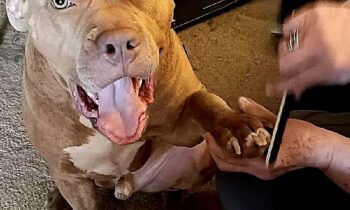
We know much more now than we did when the pandemic started in the spring of last year. We’ve learned a lot from our experiences—some of it good, some of it bad. Most importantly, we found we didn’t have all the answers. We still don’t! I hope today to offer you suggestions on how we might proceed as wisely as possible to navigate the new year with our pets more safely and sanely.
Visit your vet clinic virtually—catch up with changes.
Find your veterinary clinic online to view their current protocols if you haven’t been in since the pandemic started . . . or even if you just haven’t been in lately. Everything may be different from the last time you were there; adjustments may have been made.
Appointments are usually mandatory. Not sure how your pet will react to being seen without you there? Ask how to reduce your pet’s stress (and yours). Front-desk clinic staff understand your concerns and they’ll have some sound advice.
▪ Check your pet’s “medicine cabinet” for up-to-date vet-prescribed or over-the-counter medications in adequate supply for normal needs. Note what you need to get at your next vet visit or sooner.
▪ Put together a pet first-aid kit for all the pets in your household, with a good supply of what you might use to care for each pet in an emergency while you’re “on the way” to the vet.
▪ In many areas, remember a trusted skunk-spray remedy with enough of the various ingredients to “de-stink” all the possibly affected pets!
▪ Know where to get emergency veterinary treatment in your community. Keep the numbers handy for all pet emergency clinics near where you live, and know how to get there in a hurry.

Photo by Mark Cuilla
Decide who’ll take care of your pet if you can’t.
In an emergency, whether you slip on ice and break an arm or when you’re suddenly too sick to get out of bed—even if it’s not the coronavirus—you could end up temporarily being unable to take care even of yourself. When that happens, who will care for your pet? Figure it out now, why don’t you?
Decide on a family member, friend, or neighbor who is capable of pet-sitting until you recover, and ask them now. (They need to be willing as well as able to care for your pet. Why wait until the emergency has happened and somebody other than you has to figure it out?)
You do not need to break quarantine to work out the details if it’s the pet who comes and goes while you and your pet-sitter stay right where you are, in your own stay-at-homes. You can discuss arrangements by phone, you can transfer the pet’s “luggage” with careful sanitation, and you or an able-bodied friend can deliver the pet to the sitter without any physical contact between you and the other humans!
▪ If a friend needs to deliver the pet for you, put the pet in a carrier. Have your friend call you when they arrive at your address. Place the carrier on your doorstep while your friend observes from the car, then shut your front door. Watch from the window as your friend loads up the pet’s carrier and drives away.
▪ If you can manage the transfer yourself, bring the pet in a carrier that you drop off at the sitter’s door . . . and step away!
▪ A carrier not practical for your dog? Use a long line—not a flexible lead—leaving the “handle” end at the sitter’s door. The dog stays with you (or your able-bodied friend) as far from the door as possible, on the other end of the long line. The sitter comes to the door, calls the dog, you let go of the long line, the dog runs to the sitter or the sitter “hauls him in” if necessary. Of course, it’ll go much more easily if the pet knows and likes the sitter. Don’t worry—you’ll manage!
Leave your pet-sitter’s name and number on file at your pet’s veterinary clinic, including your credit-card information for any charges that might be incurred while your pet is with the sitter. Decide who, if anyone (probably not your pet-sitter), has your permission to make decisions about your pet’s veterinary care if you are not available. You might want to leave that power in the hands of a close friend or family member, rather than with a pet-sitter, since it could be a very serious decision.
Pet insurance—research it and pick a plan.
When you find the plan that fits your pet, budget what it takes to pay for it, and sign up.
Keep track of how it works in the first year. What was covered, what was not, how much have you saved . . . or lost? Would you recommend it to a friend? Will you continue your current policy and, if not, will you look around for a better fit for your situation? Be clear on what you need to submit claims; again, it’s possible your veterinary clinic front-desk staffers might have some good advice. When you first enroll, organize storage for your insurance paperwork. Later, you’ll be glad you did!
Your pet’s basic grooming—learn how to do it . . . and do it.
We’ve discovered a lot about ourselves during the first pandemic year, including how bad many of us are at self-maintenance basics when we can’t hire a professional to cut our hair or even do our nails! It’s been the same for the pets who’ve gone ungroomed because their humans had always relied on an appointment with a groomer or a vet-clinic tech to, say, “do” the pet’s nails—which should be done regularly, often more than once a month. As for pet haircuts, some humans didn’t even try. Their dogs got shaggier and shaggier as the weeks passed. The result for many of those dogs, when groomers were allowed to open, was a complete, to-the-skin shave, because that was the only fair way to deal with the condition of a coat that had not been properly maintained for such a long time.
You may not yet be allowed to watch your groomer work in person, but, if you are, will your groomer agree to give you a “tutorial” on the how-to basics of the grooming that your particular pet needs? Demonstrating and explaining skills that have taken a career to learn will mean your pet will be “on the table” longer and, of course, you will be paying for that extra time, as well you should. Yes, tip!
Invest in the proper tools—nail clippers, scissors, comb, brush—and pet “product” (shampoo, conditioner, ear stuff, under-eye cleaner). Practice, practice, practice your newly learned grooming skills, like nail-trimming, frequently. The more routine a simple grooming is in your pet’s daily life, the more likely your pet will be unstressed by regular necessary physical care, plus you’ll get better at it!
Stock up on what your pet needs—now, while you can!
Does your pet prefer a particular food? What would your pet eat instead if that food was not available? How about pets who eat prescription diets or food that’s sold only as a special order? When you can feed just one choice and that choice is out of stock with no more expected soon, it’s an emergency. There may be no “right” answer to solve that problem. Figure it out now, before it’s an emergency. Buy more than you need, find a possible alternative, order from a new source? Your best bet may be wise counsel from experienced staffers at independent, locally owned pet-supply stores.
How about other pet supplies that may be in short supply as we go into the new year? What if your pet’s favorite chews, favorite training treats, favorite pill pockets, say, are simply not for sale? Your solution might be to find an alternative, try a product you’ve never tried before, or maybe . . . learn how to produce a home-made version that’s equally acceptable to your pet? Plan ahead—starting now!
Get the help you need—consult a trainer virtually!
Do you have a pandemic puppy or kitten, picked to be a part of your family when you realized you’d have the time at home to raise a new pet? Did you rescue, foster, or adopt an animal family member—youngster or adult—because it seemed like a good plan to do that during the pandemic?
Are you still at home or possibly going back to work eventually away from home, but unsure how your new pet will react when “normalcy” returns to your life? You weren’t completely prepared for the task you’ve taken on and now you’re wondering what will happen next? Perhaps you need advice?
It’s not mandatory to leave quarantine or to go outside your “pod” or “bubble” to get the help and guidance you might need with a new pet in your home. While classes and group instruction have changed a great deal to offer more social distancing and less up-close interaction, classes and instruction—as well as counseling for pet owners—is definitely available online, regardless of where you live, as long as you have the need and willingness to pursue it. Your due-diligence is required to make absolutely sure that the direction and advice you’re being offered is ethical and effective.



